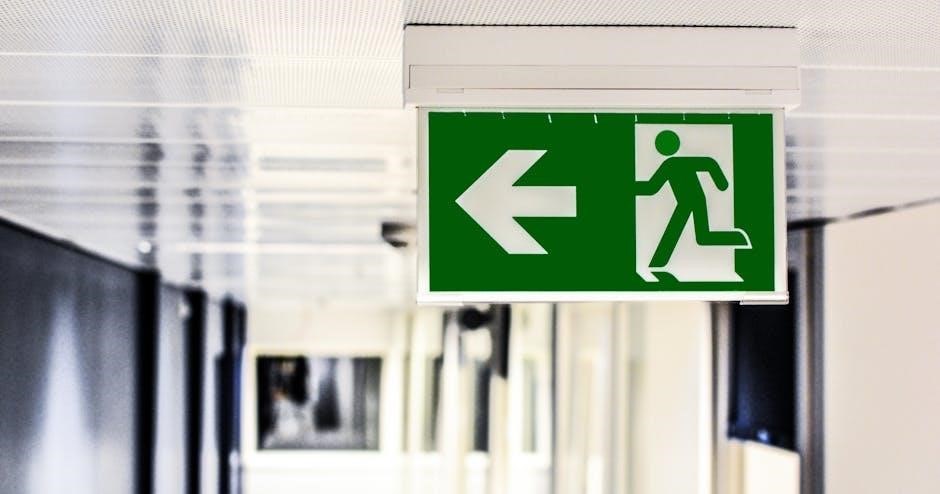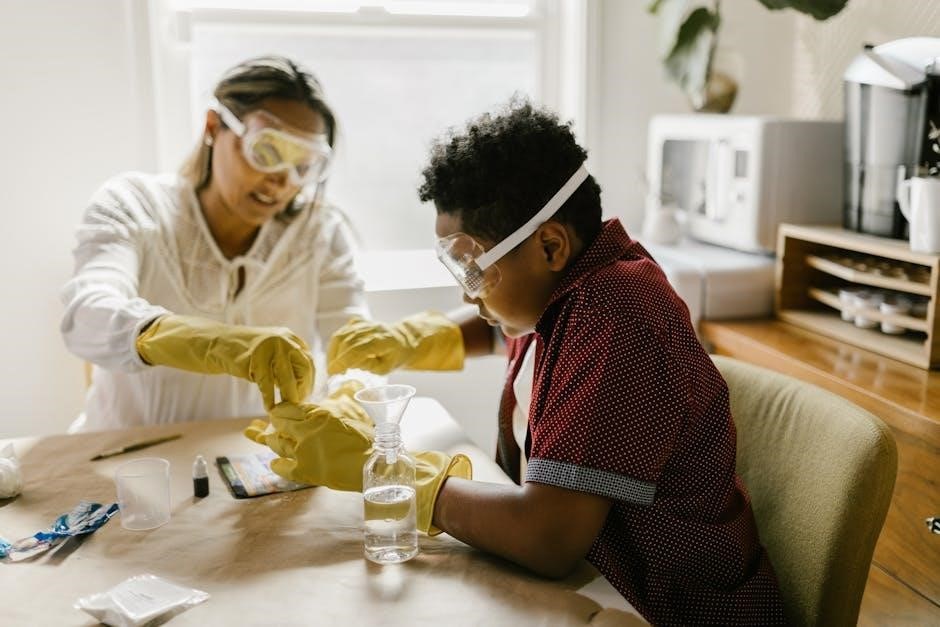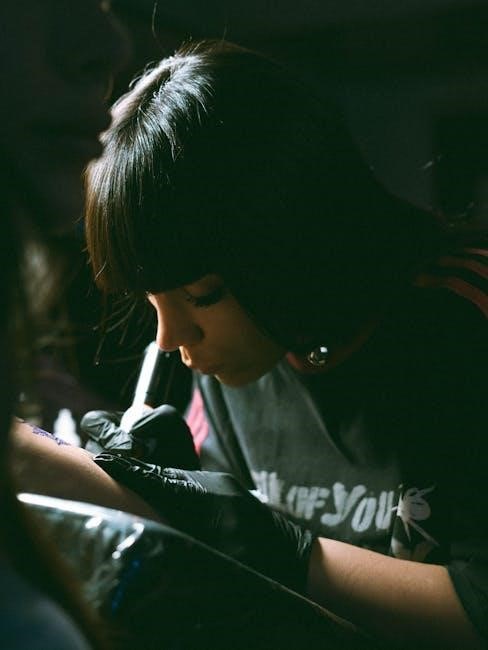Discover the art of tattooing with our comprehensive guide for beginners. Learn essential techniques, safety tips, and how to prepare for your first tattoo experience. Start your journey with confidence and creativity, ensuring a safe and rewarding process. This guide covers everything from choosing the right design to proper aftercare routines.
What is Tattooing?
Tattooing is an ancient art form involving the insertion of ink into the skin to create permanent designs. It uses tattoo machines to puncture the skin and deposit ink into the dermal layer. This process allows for intricate designs, symbols, and images to be permanently embedded. Tattooing is both a form of artistic expression and a means of cultural or personal identity. It has been practiced across various cultures for centuries, evolving into diverse styles. Modern tattooing combines traditional techniques with advanced equipment, making it accessible and customizable for individuals seeking unique body art. The art continues to grow, offering endless possibilities for creative expression.
Why People Get Tattoos
Tattoos are a form of artistic expression and personal identity. People get tattoos to commemorate life events, express individuality, or showcase cultural heritage. They serve as a means to honor loved ones, symbolize personal growth, or represent spiritual beliefs. Tattoos can also be a way to enhance beauty or celebrate milestones. For many, they are a permanent reminder of resilience and self-expression. Each tattoo tells a unique story, making it a deeply personal and meaningful experience. This art form allows individuals to wear their identity, passions, and values on their skin, creating a lasting connection to their beliefs and experiences.
Popular Tattoo Styles for Beginners
For newcomers, popular tattoo styles include minimalistic designs, small symbols, and simple linework. These styles are ideal for those new to tattoos due to their ease and versatility. Minimalistic tattoos focus on clean lines and subtle details, making them timeless and elegant. Small symbols, like dots or stars, are discreet yet meaningful. Simple linework emphasizes bold, straightforward designs, perfect for beginners. These styles are great for those looking to start small or test the waters before committing to more complex art. They also allow for easy customization and personalization, ensuring the tattoo reflects individual tastes and preferences.

Preparing for Your First Tattoo
Research artists, understand the process, and ensure proper physical and mental preparation; Hygiene, comfort, and clear communication with your artist are key for a positive experience.
Choosing the Right Design
Choosing the right tattoo design is a personal and meaningful decision. Reflect on your values, experiences, or interests to ensure the design resonates with you. Consider size and placement, as visibility and longevity matter. Think about future implications, like career or personal life. Research styles and themes that align with your vision. Consult with your artist to refine ideas and ensure compatibility with your skin tone and body shape. Start small if unsure, and remain open to adjustments. Take your time—your tattoo is a permanent expression of your identity.
Understanding the Tattoo Process
Understanding the tattoo process helps beginners feel prepared and informed. The process begins with a consultation to discuss design and placement. On the day of the session, the artist prepares a stencil or freehand design. The tattoo machine is used to deposit ink into the skin, creating the desired image. The sensation can vary but is often described as discomfort rather than intense pain. Sessions can last from minutes to hours, depending on the design’s complexity. After completion, the artist provides aftercare instructions to ensure proper healing. The process is collaborative, with the artist guiding you through each step.
Mental and Physical Preparation
Mental and physical preparation is crucial for a smooth tattooing experience. Stay calm and well-rested to manage anxiety. Avoid alcohol, caffeine, and blood-thinning medications beforehand. Eat a nutritious meal to maintain energy levels during the session. Wear comfortable clothing that allows easy access to the tattoo area. Hydrate well to ensure your skin is in optimal condition. Mentally prepare for discomfort, but remember it’s temporary. Follow your artist’s advice to ensure you’re physically and mentally ready. Proper preparation enhances your experience and supports the best outcome for your tattoo.

Tattoo Equipment Basics
Tattooing requires essential tools like machines, needles, ink, and power supplies. These devices work together to create permanent designs on the skin safely and effectively.
What is a Tattoo Machine?
A tattoo machine is an essential tool used to permanently mark designs onto skin. It operates by driving a needle up and down at high speed, puncturing the skin to insert ink. The machine consists of a motor, a needle bar, and a tube. The motor powers the movement, while the needle bar holds the needles that puncture the skin. Tattoo machines can be either rotary or coil-based, each with unique characteristics. They are crucial for creating precise, detailed designs and are used by professionals worldwide to achieve artistic and lasting results in tattooing.
Types of Tattoo Machines
Tattoo machines come in two primary types: rotary and coil. Rotary machines use a small motor to drive the needle up and down, offering quiet operation and versatility for various techniques. Coil machines, the traditional option, rely on electromagnetic coils to move the needle, providing more control for detailed work. Both types are widely used, but rotary machines are often preferred for their ease of use and reduced vibrations, making them ideal for beginners. Understanding the differences helps artists choose the right tool for their style and skill level.
Tattoo Needles and Their Uses
Tattoo needles are essential tools in tattooing, designed for specific techniques. Liner needles create fine outlines and details, while shader needles are used for shading and filling in larger areas. Magnum needles are thicker, ideal for bold lines and shading. Each needle type varies in diameter and configuration, influencing the outcome of the tattoo. Proper needle selection ensures precision and quality, making it crucial for artists to understand their uses. Needles must be sterile and single-use to maintain safety and hygiene standards, preventing infections and ensuring a smooth healing process for clients.
Tattoo Ink Safety
Tattoo ink safety is crucial for preventing health risks. Inks are made from pigments suspended in a carrier solution, ensuring even application. Reputable brands adhere to safety standards, though regulations vary globally. The FDA and EU enforce stricter guidelines to minimize harmful chemicals. Some inks contain heavy metals or toxins, which can cause allergic reactions or complications. Always choose high-quality, sterile inks from trusted manufacturers. Avoid homemade or untested mixtures, as they pose serious health risks. Ensure your artist uses certified products to safeguard your well-being. Proper ink handling and storage also prevent contamination and ensure optimal results.
Safety and Hygiene
Safety and hygiene are paramount in tattooing. Proper practices protect both artists and clients from infections and health risks, ensuring a clean and secure experience.
Hygiene Practices in Tattooing
Proper hygiene practices are essential in tattooing to ensure a safe experience. Studios must use autoclaves to sterilize equipment, disposable needles, and gloves to prevent cross-contamination. The tattoo area should be clean, with surfaces sanitized before and after each session. Artists should wash hands thoroughly and maintain a hygienic environment. Clients should also follow aftercare instructions to avoid infections. A clean workspace and adherence to hygiene protocols build trust and minimize health risks, making it a priority for both artists and clients.
Sterilization and Sanitation
Sterilization and sanitation are critical for safe tattooing. Tattoo equipment, like needles and machines, must be sterilized using autoclaves to eliminate bacteria and viruses. Disposable needles and tubes reduce cross-contamination risks. Studios should follow strict sanitation protocols, including cleaning surfaces with hospital-grade disinfectants and ensuring the workspace is spotless. Handwashing is essential before and during sessions. Artists should wear gloves to maintain hygiene. Proper sterilization and sanitation protect both clients and artists from infections, ensuring a safe and healthy tattooing experience. Studios must adhere to state and local health regulations to maintain high standards.
Legal Age Requirements
In most regions, the legal age to get a tattoo is between 16 and 18 years old, depending on local laws. Minors typically require parental consent to receive a tattoo. Studios often enforce their own age policies, with some requiring clients to be at least 21. It’s essential to research and understand the laws in your area to ensure compliance. Reputable tattoo artists and studios adhere to these regulations to maintain safety and avoid legal issues. Always verify the legal requirements before making a tattoo appointment to avoid any complications.

Understanding the Tattoo Process
Understanding the Tattoo Process involves consultation, stencil application, and the actual tattooing session. Proper preparation and aftercare are crucial for a successful outcome; Artists guide clients through each step.
How Tattoos Are Made
Tattoos are created by inserting ink into the dermis using a tattoo machine. The process begins with a consultation to discuss design preferences; A stencil is then applied to ensure accuracy. During tattooing, the machine moves a needle up and down, puncturing the skin and depositing ink. Different needles are used for outlining (liners) and shading/coloring (shaders). The artist works layer by layer, building detail and depth. After completion, the tattoo is cleaned, and aftercare instructions are provided to promote healing and prevent complications. Proper hygiene and technique are essential for a safe and successful outcome.
Choosing the Right Tattoo Artist
Selecting a skilled and reputable tattoo artist is crucial for a positive experience. Research local artists, review their portfolios, and ensure their style aligns with your design preferences. Look for consistency in their work and read testimonials from past clients. A professional artist will prioritize hygiene, use sterile equipment, and guide you through the process. Don’t hesitate to ask questions about their experience or techniques. Building trust and clear communication are key to achieving your desired outcome. A reputable artist will also provide aftercare advice to ensure proper healing.
Making a Tattoo Appointment
Booking a tattoo appointment is an exciting step. Start by contacting reputable studios or artists directly through their websites or social media. Many artists require a consultation to discuss your design ideas and preferences. Be prepared to share reference images and explain your vision. Some studios may request a deposit to secure your appointment. Ensure you understand the process, timeline, and costs involved. Arrive early for your session, wear comfortable clothing, and bring any necessary items, like snacks or water. Clear communication with your artist ensures a smooth experience.
What to Expect During the Session
Upon arrival, your artist will prepare the stencil and setup. The session begins with transferring the design onto your skin. The tattoo machine will create a buzzing sound as the needle inserts ink into the skin. Expect mild discomfort, though pain levels vary by area. Breaks are taken to allow the artist to work accurately and for you to rest. Stay hydrated and communicate any needs. After completion, the artist will clean the tattoo, apply aftercare products, and provide instructions for healing. The process is collaborative, ensuring you’re satisfied with the final result.

Tattoo Aftercare and Healing
Proper aftercare involves keeping the tattoo clean, moisturized, and protected from sunlight. Avoid submerging it in water and use recommended products to promote healing and prevent infections.
Importance of Proper Aftercare
Proper aftercare is crucial for tattoo healing, as it prevents infections and ensures the design looks its best. Neglecting aftercare can lead to scarring, fading, or prolonged recovery. Keeping the tattoo clean and moisturized helps the skin heal faster and reduces the risk of complications. Proper aftercare also supports the immune system in fighting off bacteria. By following a consistent routine, you protect your investment and ensure the tattoo remains vibrant and healthy. Ignoring aftercare can result in irreversible damage, emphasizing why it’s a cornerstone of the tattooing process.
Stages of Tattoo Healing
The tattoo healing process involves several stages. Initially, the tattoo is red, swollen, and may ooze ink, lasting a few days. Next, a scab forms, and the skin begins to peel, similar to a sunburn, over 1-2 weeks. Finally, the tattoo enters the maturation phase, where the skin fully regenerates, a process taking several months. Proper aftercare ensures smooth healing, preventing scarring and promoting vibrant colors. Each stage requires attention to prevent complications and achieve optimal results.
Common Mistakes to Avoid
Beginners often make mistakes that can affect their tattoo experience. One common error is not researching the artist thoroughly, leading to poor-quality work. Another mistake is rushing into a design without considering its long-term implications. Ignoring aftercare instructions can result in infections or prolonged healing. Additionally, touching the tattoo with unwashed hands can introduce bacteria. Lastly, some individuals neglect to maintain their tattoo’s appearance over time, causing fading or distortion. Avoiding these mistakes ensures a positive and satisfying tattoo journey.
Recommended Aftercare Products
Proper aftercare requires the right products to ensure healing and maintain your tattoo’s quality. Aquaphor Healing Ointment and Bepanthen are highly recommended for their soothing and protective properties. Natural soaps like Dr. Bronner’s are ideal for gentle cleansing. Once peeling begins, switch to a fragrance-free moisturizer like Lubriderm or Aveeno. Avoid harsh chemicals, alcohol, or petroleum-based products, as they can irritate the skin or fade ink. Always choose products free from harmful additives to promote healthy healing and preserve your tattoo’s vibrancy.

Building Your Tattoo Portfolio
A portfolio showcases your artistic style, progress, and versatility as a tattoo artist. Include high-quality images of your best work, organize pieces by style, and regularly update it to reflect your growth and creativity.
Why You Need a Portfolio
A portfolio is essential for showcasing your skills and attracting clients. It demonstrates your artistic range, style, and attention to detail, helping potential clients trust your work. A well-curated portfolio highlights your best pieces, proving your credibility as a tattoo artist. It also serves as a marketing tool, allowing you to stand out in a competitive industry. By displaying your versatility and specialization, you can appeal to clients seeking specific tattoo styles. Additionally, a portfolio fosters continuous improvement, as reviewing your work helps identify areas for growth and refinement; It’s a vital tool for building your reputation and career in tattooing.
How to Create a Portfolio
Creating a portfolio is crucial for showcasing your tattooing skills. Start by gathering high-quality images of your best work, ensuring clarity and proper lighting. Organize your pieces by style, such as black and grey or color work, to highlight your versatility. Consider including sketches or drafts to demonstrate your creative process. Decide between a physical portfolio for in-person meetings and a digital one for online accessibility. Use platforms like Instagram or websites like Behance to share your work professionally. Include testimonials from clients to build credibility and keep your portfolio updated regularly to reflect your growth as an artist.
What to Include in Your Portfolio
Your portfolio should showcase your best tattoo work, highlighting versatility and skill. Include high-quality images of finished tattoos, as well as healed results to demonstrate long-term quality. Add sketches or concept art to reveal your creative process. Incorporate a variety of styles, such as black and grey, color, or minimalist designs, to appeal to diverse client preferences. Testimonials from satisfied clients can enhance credibility. Ensure consistency in presentation, with clear organization and professional formatting. Regularly update your portfolio to reflect growth and mastery of new techniques, keeping it concise yet comprehensive.

Marketing Yourself as a Tattoo Artist
Building a strong personal brand and showcasing your unique style are crucial for attracting clients. Utilize social media platforms to share your work and engage with potential customers.
How to Find Clients
Building a client base requires strategic marketing and networking. Start by creating a professional online presence through social media platforms like Instagram and Facebook, where you can showcase your portfolio and interact with potential clients. Use hashtags to increase visibility and engage with your audience. Collaborate with other artists or local businesses to cross-promote services. Offer custom consultations to understand client needs and build trust. Consider promotions or discounts for first-time clients to attract new business. Word-of-mouth referrals are also a powerful tool, so encourage satisfied clients to share their experiences.
Using Social Media for Promotion
Platforms like Instagram and Facebook are essential for showcasing your tattoo work and attracting clients. Create a professional profile with a portfolio of your best pieces. Use relevant hashtags to increase visibility, such as #tattooartist or #tattooideas. Post high-quality images and share behind-the-scenes content to engage your audience. Respond promptly to comments and messages to build connections. Collaborate with influencers or other artists to expand your reach. Consistency is key—regular updates keep followers interested and help grow your reputation in the tattoo community.
Networking in the Tattoo Industry
Building relationships within the tattoo community is crucial for growth. Attend tattoo conventions and workshops to meet artists, learn new techniques, and gain exposure. Collaborate with other artists on projects or guest spots to expand your network. Join online forums and local tattoo groups to connect with peers and potential clients. Engage in meaningful conversations and be open to feedback. Building trust and respect within the industry fosters opportunities and supports your journey as a tattoo artist. Networking is about mutual growth and creating a strong foundation for your career;

Tattoo Etiquette
Respect, punctuality, and clear communication are key. Be polite to artists, arrive prepared, and follow studio rules. Good hygiene and a positive attitude foster a professional environment.
Respecting Your Tattoo Artist
Respecting your tattoo artist involves punctuality, clear communication, and valuing their expertise. Arrive on time, be open about your design ideas, and avoid bringing uninvited guests. Trust their professional judgment and follow their guidance. Respect their workspace by maintaining hygiene and avoiding disruptive behavior. Acknowledge their creativity and time invested in your tattoo. Building a positive relationship ensures a better experience and a high-quality result. Remember, mutual respect fosters collaboration and a successful tattoo session.
Communication During the Tattoo Process
Effective communication is crucial during the tattoo process. Be clear about your design preferences, pain tolerance, and any concerns. Ask questions to ensure you understand the process and timeline. Provide feedback during the session to guide the artist accurately. Discuss aftercare instructions thoroughly to ensure proper healing. Active listening and openness from both the client and artist foster a collaborative environment, leading to a satisfying outcome. Clear dialogue helps avoid misunderstandings and ensures the final tattoo meets your expectations. Communication is key to a successful and enjoyable experience for both parties involved.
Tattoo Studio Etiquette
Respect and courtesy are essential in a tattoo studio. Arrive on time for your appointment and be prepared. Avoid disruptive behavior, such as loud talking or using phones excessively. Refrain from touching equipment or artwork unless permitted. Show respect for the artist’s expertise and the creative process. Follow studio rules, such as no alcohol or drugs, and maintain personal hygiene. Be mindful of other clients and keep noise levels low. Treating the studio and artist with respect ensures a positive experience for everyone. Proper etiquette fosters a professional and comfortable environment.

Advanced Tattoo Techniques
Explore advanced methods like intricate shading, vibrant color blending, and hyper-realistic designs. Mastering these skills requires practice, patience, and continuous learning to achieve stunning, professional results.
Shading and Color Work
Shading and color work are essential techniques in tattooing, adding depth and vibrancy to designs. Shading involves layering ink to create dimension, while color work focuses on blending hues for realism. Proper needle selection and ink saturation are crucial. Practice gradient transitions and subtle shifts to achieve smooth results. Beginners should start with simple shading exercises before progressing to complex color schemes. Study how light interacts with skin tones to master realistic shading. Avoid over-saturating areas, as this can lead to muddy textures. Consistency and patience are key to refining these skills for professional-quality tattoos.
Realism vs. Traditional Tattoos
Realism and traditional tattoos are two distinct styles with unique characteristics. Realism focuses on lifelike details, often using shading and color to replicate real-world imagery. It’s ideal for portraits, landscapes, and intricate designs. In contrast, traditional tattoos feature bold lines, bright colors, and iconic imagery like anchors or roses. This style emphasizes simplicity and symbolic meaning. Beginners should consider their personal preference and the intended visual impact when choosing between these styles. Both require skill, but traditional tattoos are often more accessible for new artists due to their straightforward techniques and timeless appeal.
Custom Tattoo Design Tips
Creating a custom tattoo design involves collaboration between you and your artist. Start by gathering reference images to convey your vision clearly. Share personal stories or symbolism behind your design to ensure it resonates. Be open to your artist’s feedback, as they can enhance your idea while maintaining artistic integrity. Consider the placement on your body, as this affects the design’s size and detail. Keep your concept simple for your first tattoo, allowing room for future expansion. Trust the process and communicate openly to achieve a meaningful, one-of-a-kind piece.

Continuous Learning and Growth
Dedication to learning and growth is essential for mastering tattooing. Attend workshops, stay updated with trends, and practice regularly to refine your skills and artistic vision.
Importance of Apprenticeships
Apprenticeships are crucial for beginners in tattooing, offering hands-on training and mentorship. Working under an experienced artist provides insight into techniques, safety protocols, and industry standards. It helps build a strong foundation, allowing learners to refine their skills and gain confidence. Apprenticeships also foster creativity and professionalism, essential for a successful career. They provide opportunities to learn about client interactions, studio management, and the business side of tattooing. Through consistent practice and guidance, apprentices can develop a unique style and establish a reputable portfolio.
Attending Tattoo Conventions
Attending tattoo conventions is a valuable experience for beginners, offering exposure to diverse artistic styles and techniques. These events allow networking with professional artists, learning about industry trends, and gaining insights into the latest tools and practices. Workshops and live demonstrations provide hands-on learning opportunities. Conventions also showcase the work of renowned tattooists, inspiring creativity and helping beginners refine their personal style. Engaging with the tattoo community fosters growth and understanding of the craft, making conventions an essential step in a beginner’s journey to becoming a skilled tattoo artist.
Staying Updated with Trends
Staying updated with tattoo trends is crucial for beginners to understand the evolving industry. Social media platforms like Instagram and Pinterest showcase the latest styles, from minimalism to neo-traditional designs. Adaptability to trends helps artists cater to client preferences while maintaining personal creativity. Current trends often include delicate linework, geometric patterns, and vibrant color schemes; Continuous learning through online resources, workshops, and conventions ensures artists remain relevant. Balancing trend awareness with personal style is key to developing a unique artistic voice in tattooing.
